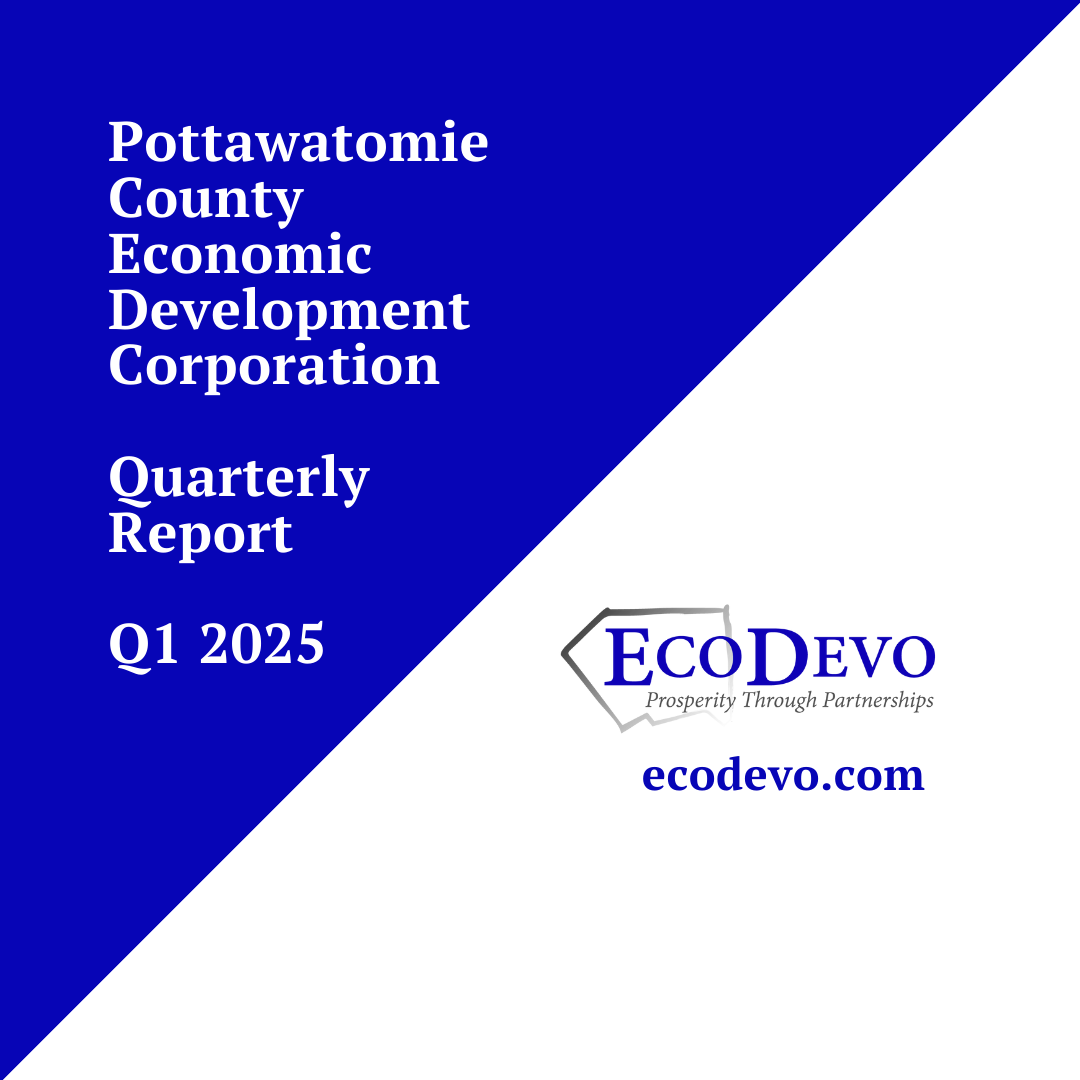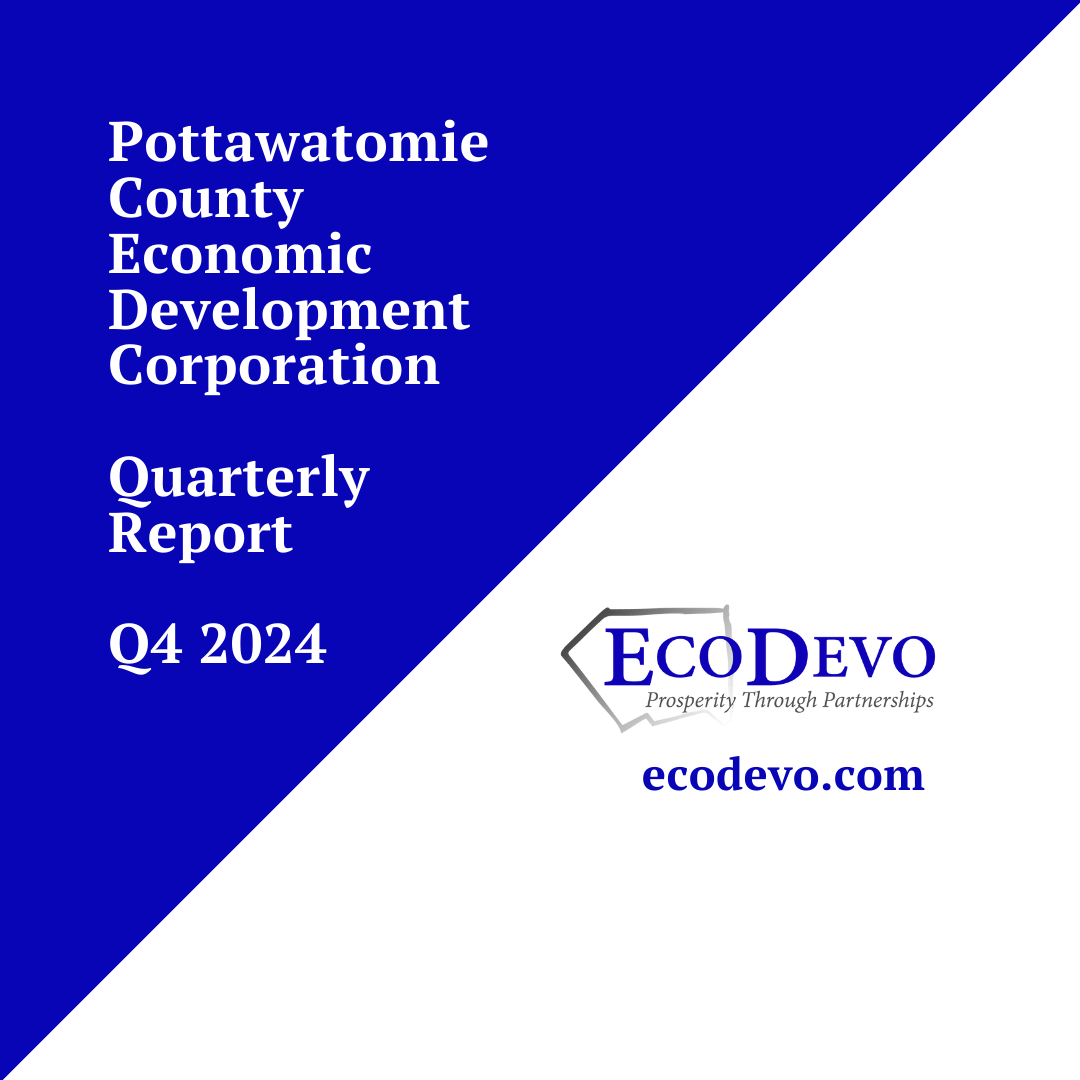
By: The Pottawatomie County Economic Development Corporation (PCEDC) | 4.28.25
Pottawatomie County’s initial economic data for 2025 includes strong labor force data and year-over-year sales and use tax growth. While these indicators started off strong, home sales were slow, even seasonally, with year-over-year data for home closings trailing last year’s cumulative data for the same time period -25% – this may reflect local trends only, but also fits into a national narrative of financial uncertainty and a difficult housing market, particularly for lower-to-medium-income buyers. Pottawatomie County’s (unadjusted) unemployment rates also crept up a bit higher than in the past few months, but still mirrored similar numbers from mid-2024.
Download a printer-friendly version of the Q1 2025 Quarterly Report.

Pottawatomie County Employment & Workforce
Pottawatomie County’s labor force, defined by those working or looking for work, frequently fluctuates, but has remained in a strong place over the past several months, coming in at just around 13,900 in the Kansas Department of Labor Information Center’s March data. Each month Pottawatomie County’s unemployment rate has sat below the state-wide unemployment rate (3.9%, 4.1%, and 3.8%, for January, February, and March, respectively), demonstrating that the county has remained well-positioned as a county with an effectively engaged workforce. Riley County’s unemployment rates also remained within a similar range over the first quarter, albeit with a larger labor force.


Pottawatomie County Sales Tax and Retail Sales Data
Sales and use tax collections for Pottawatomie County started off strong, with a year-over-year increase of over $94,000 by the end of Q1. This suggests that commercial activity has started off strong in the new year, although uncertainty remains as to what’s next for prices and consumer behavior.

Pottawatomie County Housing Trends
Historically, winter months have been slowest for home sales in Pottawatomie county. However, the count of home closings for early 2025 have been lower than those during the past few years; in 2023, 60 homes had sold by the end of Q1, compared to 52 in 2024, and only 39 in 2025, according to the latest market update by the Flint Hills Association of Realtors. Interestingly, the corresponding report for Riley County shows a less distinct trend, with home closings shifting from 111, to 168, and back down to 141 during the first quarters of 2023, 2024, and 2025, respectively.
While local trends can be difficult to attribute to a national narrative, housing supply and affordability remains an issue, both in the Flint Hills region and beyond. Median home prices for Pottawatomie county hovered over $360,000 in March, a price point which may be beyond reach for many first-time home buyers.

Based on past trends, we can anticipate seeing a boost in home sales moving into the summer months, assuming availability of for-sale properties. However, particularly uncertain financial conditions could impact trends – the full impacts are yet to be seen, although speculation abounds regarding the future of the housing market, with predictions ranging from expectations of higher costs for new home builds, to suggested slowdowns in rising home prices, and predictions that market stagnation will only clear if interest rates drop significantly (which is only expected to happen on a marginal level by the end of the year).
National & Global Concerns
Median household incomes were around $77,7000 in 2023, according to USA Facts. This number, which was adjusted for inflation, actually represents a (very) slight decrease from the year prior, and incomes are reported to have been highest in 2019. At the same time, however, about 40% of U.S. households brought in more than $100,000, demonstrating how the median income number may or may not accurately describe the income generated by any specific household – especially if geography and household composition aren’t considered.
The national distribution of household incomes looked like this is 2023:

While incomes and inflation generally remain a concern for consumers, recent national-level data may suggest some relief. Another recent article from USA Facts cites BLS data to report that wage growth has outpaced inflation from March 2024 to March 2025, suggesting an increase in consumers’ purchasing power. While this is positive news for those experiencing wage growth consistent with this trend, those not seeing wage growth may still feel pressures of inflation. Additionally, the positive inflation rate is still an indicator of rising prices, and consumers shouldn’t expect to see prices come down from the past years’ increases any time soon; these dynamics likely contribute to a sense of discontinuity between a national discourse dominated by inflation concerns and this seemingly conflicting data.

The Data Center Boom and What it Requires
As big tech companies continue to invest in innovation, including AI tools, data centers have steadily popped up across the country, including in Kansas. This burgeoning industry has been enthusiastically watched, with states offering or considering (as the Kansas legislature recently has) implementing economic development incentives to bring in data center projects and investment. So what is required to actually support the power needs for data centers? Sherwood news reports that power requirements for data centers are expected to double by the end of the decade, and that natural gas currently supplies around 40% of data centers’ power needs. With needs for power only increasing, it seems that natural gas will continue to be a large part of the picture for powering data centers in the coming years, although some companies are also exploring alternatives.
All of that said, the data center industry is one of many that stands to be highly impacted by tariffs, particularly as many big tech companies utilize foreign-made components and equipment. With the potential for projects to be cancelled or downsized due to changes in feasibility, projections for data center power needs may or may not hold true.

Download a printer-friendly version of the Q1 2025 Quarterly Report.






